The Latest from Boing Boing |  |
- European Internet sinking fast under 3-strikes proposals
- The Cove director on watching his film with the dolphin killers
- Makers launch in London next THU, OCT 29 (CORRECTED!) at Forbidden Planet
- Fake car key is a spy video camera
- Infographic of Mars missions
- Interfictions online story-thinggums
- Junk Dunks: Nike Airs made out of consumer waste
- Chamber of Commerces tries to Ralph Lauren the Yes Men
- Australian public broadcaster releases Zombie Walk footage under Creative Commons
- Collecting drug use data via cell phone
- Iran: blogger Hossein "Hoder" Derakshan said to have been jailed in solitary for 10 months
- Sony unveils new 3D display
- Art That Illustrates the Danger of Antibacterial Everything
- DWI in motorized easy chair
- Digital Open Winners: Australian Teen Crafts "Sneaky" Games
- Rare photos of a North Korea amusement arcade
- Farmer grows pumpkins with human faces
- Computopia, a circa 1969 vision of the future from Japan
- Scans of Google Books with fingers in them
- Scientist: Hugh Hefner Owes Everything to the Evolution of Color Vision
- Gallery of creepily retouched baby photos
- Testosterone levels of men who voted for McCain dropped
- Living In Sim: Justine Cooper's medical mannequin soap opera art
- Silent film re-edit of so-called "drunkest guy ever" surveillance video
- Communist-era store windows
- Shel Silverstein's UNDERWATER LAND, CD/book of hilarious kids' nautical music
- A drink that sounds even more unappetizing than "Dairy Drink"
- Building a brain inside a supercomputer
- LEGO recreation of Buddhist temple in Kyoto
- US military data-mines America's kids for war recruiting
| European Internet sinking fast under 3-strikes proposals Posted: 23 Oct 2009 05:05 AM PDT Things look bad for the European Internet: "3 strikes" (the entertainment industry's proposal for a law that requires ISPs to disconnect whole households if one member is accused -- without evidence or trial -- of three copyright infringements) is gaining currency. Efforts to make 3-strikes illegal are being thwarted by the European bureaucracy in the EC. The Pirate Party, which holds a seat in the European Parliament, proposed legislation that said, essentially, that no one could be disconnected from the Internet without a fair trial. When the proposal when to the European Commission (a group of powerful, unelected bureaucrats who have been heavily lobbied by the entertainment industry), they rewrote it so that disconnection can take place without trial or other due process. On the national level, France's Constitutional Court have approved the latest version of the French 3-strikes rule, HADOPI, which has created a kind of grudging, joke oversight by the courts (before your family's Internet connection is taken away, a judge gives the order 1-2 minutes' worth of review, and you aren't entitled to counsel and the rules of evidence don't apply -- the NYT called it similar to "traffic court"). Under this rule, there is now a national list of French people who are not allowed to be connected to the Internet; providing them with connectivity is a crime. The only bright light is that this will play very badly in the national elections coming up in many European jurisdictions; the Swedes, in particular, are likely to kick the hell out of the MPs who voted for criminal sanctions for downloading and replace them with Pirate Party candidates, Greens, and members of other parties with a liberal stance on copyright. 3-Strikes For Pirates Makes European Comeback Tour Previously:
|
| The Cove director on watching his film with the dolphin killers Posted: 23 Oct 2009 04:28 AM PDT  The Cove, the provocative film that documented the hidden dolphin slaughters in Taiji, Japan, made its Japan debut at the Tokyo International Film Festival this week, and director Louie Psihoyos was there to bear witness to its unveiling. I talked to him just two hours after he got off the airplane from Narita on Thursday morning. Here's what he had to say about his experience in watching the film with the actual dolphin killers in the audience: The Cove, the provocative film that documented the hidden dolphin slaughters in Taiji, Japan, made its Japan debut at the Tokyo International Film Festival this week, and director Louie Psihoyos was there to bear witness to its unveiling. I talked to him just two hours after he got off the airplane from Narita on Thursday morning. Here's what he had to say about his experience in watching the film with the actual dolphin killers in the audience: All the bad guys there, front row center. The mayor, the International Whaling Committee delegate, fishermen dressed up in suits...I couldn't have dreamed of a better screening. They had all come to Tokyo with their lawyers to see if there would be any kind of litigation against the film. The screening sold out within a few hours, so I offered to give them tickets. At one point, the mayor stormed out, and the IWC delegate held his head in his hands. I thought I might get arrested when I got off the airplane in Tokyo — there are arrest warrants out for me in Taiji for things like trespassing, conspiracy to disrupt commerce, and photographing undercover police. I was invited by the TIFF, though, so that's probably what kept me safe. Stories about dolphin hunting have been taboo in Japan for the past 30 years. The only reason this film was able to show there this week was because the Liberal Democratic Party was voted out. The government is a major sponsor of the film festival, and about two weeks after the regime change, the festival's director contacted me and said, "Given the 'environment' theme of this year's film festival, it would be hypocritical not to show The Cove." Still, the festival did seem to bury it — we had a 10:30AM screening and not a single promotional poster in sight. All the Japanese who approached me about the film had very positive things to say about it. It was mostly young people, 18-35 year olds. They said, how can I help you get this film out in Japan? I think many were in shock. I told them that this was just the Disney version of what really happens at the cove. During the Q&A session, I pointed out that this is not just an animal rights film, but that these dolphins have about 5000 times more mercury than allowed by Japanese law. Unfortunately, it's not enough to argue that these are the only animals in human history that have saved humans. The only way we can save them is by reminding people that human beings have made their environment so toxic that we can't eat them anymore. The question of intelligence of other animals as judged by our own intelligence is such a specie-centric thing. We're about to go through our sixth major extinction now, so how smart does that make us really? I think the most important thing that could happen is that the film would show in Taiji. I've sent them a formal letter to see if they'd like to do an ocean-themed film festival at a national park that would include The Cove. I also told the Taiji mayor and councilmen that all profits generated from the film in Japan would go directly to the dolphin hunters if they stopped their dolphin hunting. I would gladly support them if they switch to crab hunting or whale watching. I was only in Japan for two days — the whole thing was so surreal. At Sundance earlier this year, people thought that this movie would never screen in Japan. Now there are two major distributors in Japan negotiating for the rights. And flying back over the Pacific today, I knew there are now several thousand dolphins swimming free because of this movie. |
| Makers launch in London next THU, OCT 29 (CORRECTED!) at Forbidden Planet Posted: 23 Oct 2009 04:19 AM PDT 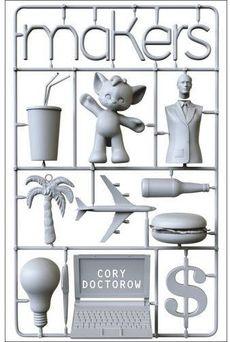 Update: Please note correct date -- Thu, Oct 29! Sorry! Update: Please note correct date -- Thu, Oct 29! Sorry! My latest novel Makers comes out next week, and I'll be launching it in the UK with a signing on Forbidden Planet Megastore: Cory Doctorow signing Makers I'll also be coming to Canada and the US next month for a quick book-tour, kicking off with a signing and reading at the Merril Collection in Toronto (Nov 12, 7pm, The Merril Collection of Science Fiction, Speculation, and Fantasy, 239 College Street, 3rd Floor, Toronto, Ontario M5T 1R5, +1 416 393-7748), and Bakka Books, the bookseller, is also glad to take orders for inscribed copies beforehand. I'll sign them all for shipping on the day. After that, I'll be coming through NYC, NJ, Boston and Philadelphia -- details are still a little shaky, but if you drop me an email, I'll send you a mailout once I have them in hand. Here's a little more about Makers, courtesy of Publishers Weekly: "In this tour de force, Doctorow (Little Brother) uses the contradictions of two overused SF themes--the decline and fall of America and the boundless optimism of open source/hacker culture--to draw one of the most brilliant reimaginings of the near future since cyberpunk wore out its mirror shades. Perry Gibbons and Lester Banks, typical brilliant geeks in a garage, are trash-hackers who find inspiration in the growing pile of technical junk. Attracting the attention of suits and smart reporter Suzanne Church, the duo soon get involved with cheap and easy 3D printing, a cure for obesity and crowd-sourced theme parks. The result is bitingly realistic and miraculously avoids cliché or predictability. While dates and details occasionally contradict one another, Doctorow's combination of business strategy, brilliant product ideas and laugh-out-loud moments of insight will keep readers powering through this quick-moving tale. (starred review)" And, of course, I'll have a site up in a couple of days with free, CC-licensed downloads of the whole text. |
| Fake car key is a spy video camera Posted: 22 Oct 2009 10:41 PM PDT      Another fun spy gadget from Brando in Hong Kong: - The FAKE Keychain Car Key Lock with REAL Security Video Record, Photo Record and Sound Record! |
| Posted: 22 Oct 2009 09:10 PM PDT 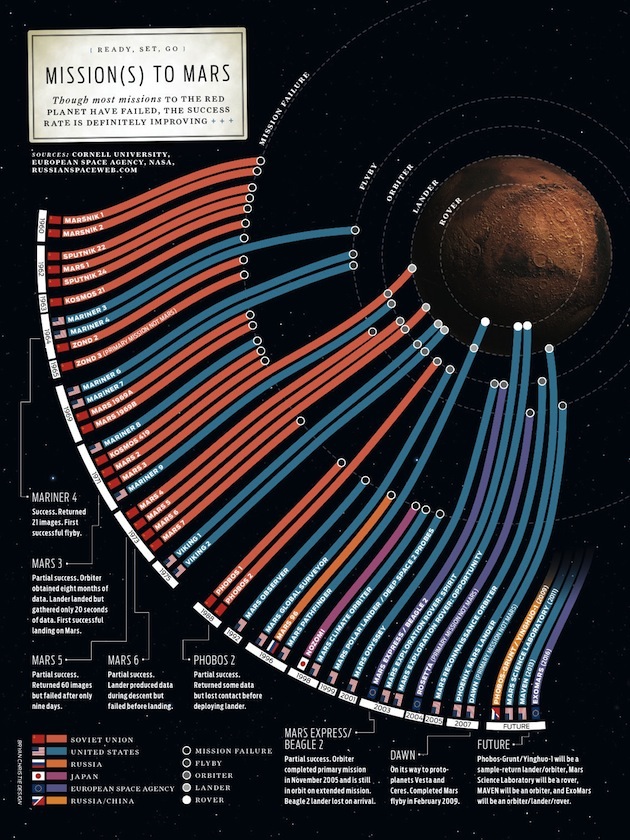 Editorial illustrator and data visualizer Bryan Christie created this fantastic graphic of Mars missions. Higher res at imgur. (via Laughing Squid) |
| Interfictions online story-thinggums Posted: 22 Oct 2009 08:49 PM PDT  Ellen Kushner sez, "The Interstitial Arts Foundation is presenting 8 new original online stories - er, pieces of interstitial writing, a new one each week for the 8 weeks leading up to the November 3 publication of our new anthology, _Interfictions 2_ . So far we've ranged from F. Brett Cox's 'Nylon Seam,' Brett's 'tribute to Bettie Page fandom'complete with soundtrack (vocals & guitar, F. Brett Cox) to Ron Pasquariello's 'Chipper Dialogues' - a man & his mutt converse in haiku. This week, it's Kelly Cogswell's story-and-poem combo, 'For the Love of Carrots' and 'The Luxembourg Gardener.' Check out the Annex Page for a complete list of stories and authors. Interstitial art is found in the interstices of recognized category and genre. " Ellen Kushner sez, "The Interstitial Arts Foundation is presenting 8 new original online stories - er, pieces of interstitial writing, a new one each week for the 8 weeks leading up to the November 3 publication of our new anthology, _Interfictions 2_ . So far we've ranged from F. Brett Cox's 'Nylon Seam,' Brett's 'tribute to Bettie Page fandom'complete with soundtrack (vocals & guitar, F. Brett Cox) to Ron Pasquariello's 'Chipper Dialogues' - a man & his mutt converse in haiku. This week, it's Kelly Cogswell's story-and-poem combo, 'For the Love of Carrots' and 'The Luxembourg Gardener.' Check out the Annex Page for a complete list of stories and authors. Interstitial art is found in the interstices of recognized category and genre. " Annex (Thanks, Ellen!) Previously: |
| Junk Dunks: Nike Airs made out of consumer waste Posted: 22 Oct 2009 08:53 PM PDT  Gabriel Dishaw's "Junk Dunks" are sculptures of totemic Nike Airs made out of consumer garbage. "Junk Dunk (Left)" (Thanks, Gareth!) |
| Chamber of Commerces tries to Ralph Lauren the Yes Men Posted: 22 Oct 2009 08:55 PM PDT Rebecca from EFF sez, "The Yes Men prank -- they put out a press release and held a spoof news conference on Monday, claiming that the Chamber of Commerce had reversed its position and would stop lobbying against a climate bill currently in the Senate -- apparently hasn't embarrassed the Chamber of Commerce enough yet. Attorneys for the group have issued a takedown demand for the website connected to the prank, claiming copyright infringement. The demand ignores the parodic nature of the stunt (parody enjoys First Amendment protection) and may just serve to put the Yes Men's criticism in the news for one more day." EFF: Chamber of Commerce Takes Aim at Yes Men (Thanks, Rebecca!) |
| Australian public broadcaster releases Zombie Walk footage under Creative Commons Posted: 22 Oct 2009 09:12 PM PDT  Gary sez, "ABC News Online (Australia) is going to release footage (photos, video, audio, text) of Sunday's Brisbane Zombie Walk, under a CC license. Content will feature on ABC Pool, for users to create their own mashups/remixes etc. Not sure if this is an Australian first, but it's pretty rare for MSM to release content like this. ABC Pool is also seeking video/audio/text with a zombie theme, either real or imagined." Project: The Dead Walk! (Thanks, Gary!) |
| Collecting drug use data via cell phone Posted: 22 Oct 2009 08:15 PM PDT Researchers studying the situational use of malt liquor and marijuana are employing an automated cell-phone calling system to collect data. The Interactive Voice Response (IVR) system calls you, well if you're involved in the study that is, and asks a series of questions about what you're up to at the moment and, I guess, whether you're stoned, drunk, or have immediate plans to be. Health behavior specialist R. Lorraine Collins at the University of Buffalo came up with the system after using PDA-based approaches to data-gathering that she says put too much responsibility on the study participant. I'd imagine that if you're really lit, you may not remember (or bother) to input the who, what, when, and where later on. From the University of Buffalo: (Collins) showed that, in what is known in the psychology research community as "ecological momentary assessment" (EMA) or "right here, right now" data collection, cell phones are more familiar to research participants and therefore training is easier; and that with IVR, data is stored instantly, removing any issues around the loss of information."Two New NIH grants Use Cell Phones to Collect Real-Time Data on Substance Use" (via Dose Nation) |
| Iran: blogger Hossein "Hoder" Derakshan said to have been jailed in solitary for 10 months Posted: 22 Oct 2009 04:23 PM PDT Fershteh Ghazi (@iranbaan) tweets that Hamed Derakhshan, brother of jailed Iranian blogger Hossein "Hoder" Derakshan, just said on @bbcpersian his brother has been held in solitary confinement for 10 months. Hoder was first arrested on November 1, 2008. Yesterday, Hoder's father wrote a letter to Iran's judiciary to appeal for his son's release. That letter was published on the website of Salaam, a reformist newspaper from Iran. (both items via Cyrus Farivar). |
| Posted: 22 Oct 2009 04:21 PM PDT In Tokyo today, Sony unveiled a 3D display that can be viewed from any direction. No glasses required, and several users can see the 3D images simultaneously from various angles. Snip: The cylindrical display case is 27 cm tall with a base of 13 cm in diameter, and features a 96 by 128-pixel resolution that looks better than might be expected. The screen displays 3D objects including a cartoon character, car, globe, and people. Sony created these objects either in 3D on a computer or by taking photographs of them from various angles. The result is that the objects appear to have depth, and can be viewed from any angle on the horizontal plane by walking around the display screen.Sony's keeping details under wraps, and hasn't explained how it works. We do know that it uses an LED light source, and that Sony claims it took about three years to develop the two demo models shown off today. The company has no immediate plans to commercialize the device, but a rep says they will develop versions with larger displays within the coming year. More: physorg, Network World TV. (via @GreatDismal) |
| Art That Illustrates the Danger of Antibacterial Everything Posted: 22 Oct 2009 03:46 PM PDT  What you're looking at is the art of bacterial adaptation. It's beautiful. It should also make you a little uncomfortable, and a little hopeful. Part of a collaboration between Professor Eshel Ben-Jacob, of Tel-Aviv University, and Professor Herbert Levine of UCSDs National Science Foundation Frontier Center for Theoretical Biological Physics, these pictures are a visual representation of the way bacteria evolve to overcome life-threatening obstacles---like, say, hand gel. The art is also about the way bacteria fight back, which involves a form of communication. The researchers hope to use that skill against the bacteria to create a new generation of antibacterial weaponry.
See more by following the link to Prof. Ben-Jacob's site. Previously: |
| Posted: 22 Oct 2009 02:04 PM PDT  Dennis LeRoy, 62, of Proctor, Minnesota, pled guilty to driving his tricked-out, motorized easy chair while drunk. After leaving a bar where he had at least eight beers, LeRoy smashed his chair into a parked car. The chair features a lawnmower engine, built-in stereo, headlights, and some sharp pinstriping. Dennis LeRoy, 62, of Proctor, Minnesota, pled guilty to driving his tricked-out, motorized easy chair while drunk. After leaving a bar where he had at least eight beers, LeRoy smashed his chair into a parked car. The chair features a lawnmower engine, built-in stereo, headlights, and some sharp pinstriping."Man pleads guilty to DWI in motorized La-Z-Boy" (Thanks, Carlo Longino!) |
| Digital Open Winners: Australian Teen Crafts "Sneaky" Games Posted: 22 Oct 2009 10:44 PM PDT (Download MP4 video or Watch on YouTube, or view with subtitles on Dotsub). Institute for the Future teamed up with Sun Microsystems and Boing Boing Video to co-host the Digital Open, an online tech expo for teens 17 and under around the world. We're publishing an 8-part series of videos profiling the winners. Today, meet 16 year old Harry Lee of Melbourne Australia. He talks with us about his "Sneaky Card" game concept, which explores social interactions between people. He was inspired by ARG and indie projects like "Bite Me," by Gamelab, and Jane McGonigal's Top Secret Dance-Off, both of which we've covered previously on Boing Boing. "I love index cards," says Harry, "And I was thinking -- hmm, how can I incorporate them into a project?" So he designed and printed these game cards, and "spread the seeds of sneakiness and espionage" into the unsuspecting pockets, math books, binders and bags and jackets of his schoolmates. I tracked most of the cards and found, with much satisfaction, that a majority of them had been passed down at least three times. The most successful story is of the card passed from student to student three times before ending up in a math teacher's jacket. The teacher found it and gave it to another math teacher, who inserted it into a student's corrected test before giving it back to him. The card passed hands once again before I lost track of it.Below, some sample cards in Harry's game. (Link to PDF). More after the jump. Previously:
|
| Rare photos of a North Korea amusement arcade Posted: 22 Oct 2009 01:03 PM PDT  Gaming blog UK Resistance has obtained several present-day photos of a depressingly bare, archaic video game arcade in Pyongyang. The person who took and submitted the photos chose to remain anonymous for safety reasons. Speaking of North Korea, the current issue of The Paris Review has an amazing article by Barbara Demick about two young North Koreans who risked their lives to make a romantic relationship work. Inside a North Korean arcade Gaming blog UK Resistance has obtained several present-day photos of a depressingly bare, archaic video game arcade in Pyongyang. The person who took and submitted the photos chose to remain anonymous for safety reasons. Speaking of North Korea, the current issue of The Paris Review has an amazing article by Barbara Demick about two young North Koreans who risked their lives to make a romantic relationship work. Inside a North Korean arcade |
| Farmer grows pumpkins with human faces Posted: 22 Oct 2009 12:25 PM PDT  This article about a farmer in Ohio who grew creepy pumpkins with human faces on them was apparently in the January 1938 issue of Popular Science. via Modern Mechanix This article about a farmer in Ohio who grew creepy pumpkins with human faces on them was apparently in the January 1938 issue of Popular Science. via Modern Mechanix |
| Computopia, a circa 1969 vision of the future from Japan Posted: 22 Oct 2009 12:11 PM PDT  Pink Tentacle has found several great images of what a 1969 edition of the Japanese comic magazine Shonen Sunday called Computopia — a future in which computers will teach our children, perform surgeries, and infiltrate our lives in otherwise useful and fun ways. Pink Tentacle has found several great images of what a 1969 edition of the Japanese comic magazine Shonen Sunday called Computopia — a future in which computers will teach our children, perform surgeries, and infiltrate our lives in otherwise useful and fun ways.   Computopia: Old visions of a high-tech future Computopia: Old visions of a high-tech future |
| Scans of Google Books with fingers in them Posted: 22 Oct 2009 11:42 AM PDT  Avi Solomon says: "If you search Google Images for "Google books fingers" you get poignant images (to my lights) of scanner worker bee hands. Makes me value the massive, anonymous and underpaid effort that goes into maintaining the 'digital' economy." Here an example. |
| Scientist: Hugh Hefner Owes Everything to the Evolution of Color Vision Posted: 22 Oct 2009 11:31 AM PDT If we humans weren't so bare, we would probably not wear robes. And then there would be no reason to disrobe. If there were no bare skin, there would be no Hefner as we know it. And, according to Mark Changizi from the Department of Cognitive Science at Rensselaer Polytechnic Institute, the reason we're bare is because we can see in color.  More talk of nudity and other dirty things after the cut... Changizi's theory, which he details in a post over at ScientificBlogging, is based on both research and speculation. But I kind of love these evolutionary "Just So Stories" like this, not necessarily as hard science, but for their ability to inspire imagination and curiosity about who we are and where we came from. The fact is, without basically re-doing human evolutionary history in a lab, we probably won't ever know for sure why certain features evolved. Or why we have some features that other animals don't. But I do find the speculation fun.
Image by Flickr user shufflepath, via CC Previously: |
| Gallery of creepily retouched baby photos Posted: 22 Oct 2009 11:16 AM PDT  In 2007 James Gunn posted this gallery of truly frightening before and after photos in which normal little girls are turned into waxen nightmares. |
| Testosterone levels of men who voted for McCain dropped Posted: 22 Oct 2009 11:00 AM PDT Researchers found that male McCain voters experienced a drop in testosterone after the tribe leader they were backing lost the election. "The findings indicate that male voters exhibit biological responses to the realignment of a country's dominance hierarchy as if they participated in an interpersonal dominance contest," wrote the researchers, whose paper appeared in the PLoS ONE peer-reviewed journal.
Dominance, Politics, and Physiology: Voters' Testosterone Changes on the Night of the 2008 United States Presidential Election (Via NY Mag Daily Intel) |
| Living In Sim: Justine Cooper's medical mannequin soap opera art Posted: 22 Oct 2009 01:06 PM PDT Heather Sparks writes for and about the medical industry. She has contributed to Wired, Popular Science, and many other publications. 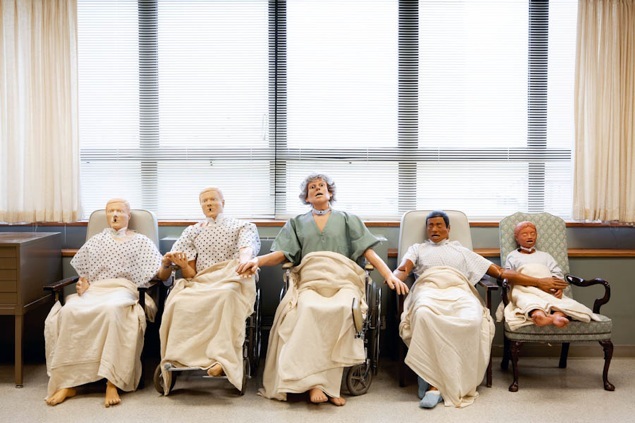 Justine Cooper is a multi-disciplinary artist living in Brooklyn whose work lies at the intersection of science, medicine, art, and commerce. Following up on HAVIDOL, a fake marketing campaign for an imaginary drug, Cooper has launched Living In Sim. This latest online and offline work presents the real and imaginary lives of medical mannequins via blog, video soap opera, installation, and photography. Living In Sim opens today, October 22, at the Daneyal Mahmood Gallery in New York City. HS: Most people have probably never seen one of these mannequins in the real world. Can you explain how they're used? JC: Medical mannequins serve as simulated patients in hospitals, universities, and clinics. Typically there is a two-room setup: one is where the simulation takes place, the second is where people direct the simulation and where everything is recorded. Software controls the mannequin's vital signs according to a script. While the simulation has a plotline, it can branch off depending on how the clinicians respond and what the learning goals may be. The whole thing can seem like improv theater or like a dress rehearsal for the real performance. The simulation finds out how the clinicians will handle everyone's needs. It can be very gripping. The Center for Medical Simulation (in Cambridge, MA) where I had a residency this past year is very advanced in their use of simulation. They stage cases that probe the limits of human and medical communication. 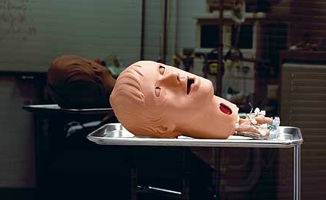 HS: What is it about the mannequins intrigued you in the first place? HS: What is it about the mannequins intrigued you in the first place?JC: I was introduced to them in Queensland, Australia four or five years ago. I work like a dung beetle; that first meeting was just a particle that got rolled along, growing and picking up ideas along the way. I started with their portraits in my last show, Terminal, but I wanted to turn their situation around and make them something more than the passive recipients of endless crises. So I made them the doctors and nurses--in fact, the whole hospital staff--and gave them a voice on the Web. HS: What do you mean when you describe Living in Sim as a "mixed reality" artwork? JC: Living in Sim is like our lives right now--where online and real-world realities are so intertwined. So much of what we do now is a hybrid. Online communication has real world ramifications, and so do medical simulations, which rely on the suspension of reality to actively seek improvements in healthcare. HS: To that end, how would you rate the level of "realness" of the mannequins compared to our Internet- and media-saturated lives? JC: Both are equal in that both impact our "real" lives. The mannequins help reduce the number of accidental deaths and medical error. But by giving these mannequins a voice on their blog [lead writer is Jason Lindner], and allowing them to act out their dramas in their soap opera, they're more real, and more like us, than ever. HS: In the soap opera piece, Indemnity General, a patient's insurance takes his wife in exchange for his medical treatment. Why did you choose to play out such an outlandish drama? JC: I really wanted to express how absurd the health industry is now. Hospitals are basically run by insurance companies like medieval fiefdoms. No, they do not take your wife as payment for services rendered, but they can be responsible for you losing your home. In fact, three-quarters of the people who are bankrupted by medical bills actually had insurance when they got sick. 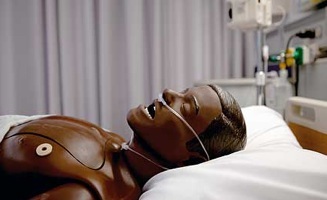 But the absurdity of Living in Sim is also intended to be playful and engaging. I'm interested in finding out if discussions about health care or medicine can be humorous. There's been so much serious debate and depressing rhetoric, is it possible to have a forum that leaves you smiling and not suicidal about the state of affairs? But the absurdity of Living in Sim is also intended to be playful and engaging. I'm interested in finding out if discussions about health care or medicine can be humorous. There's been so much serious debate and depressing rhetoric, is it possible to have a forum that leaves you smiling and not suicidal about the state of affairs?HS: There are so few actual humans in Living in Sim but instead features all this technology intended to ensure human life. Let's talk about that contradiction. JC: I think it's telling that even the small bit of humanness that the mannequins have is enough to make people engage with them very seriously in medical simulations. It's also telling that we're so surrounding by technology in our healthcare system that people insist on using it most of the time. Your knee hurts for a while and you insist on an MRI, not physical therapy. Technology shouldn't negate common sense in healthcare, but it often does. HS: You also have taken several photos of the mannequins with religious and classical symbolism in them. Why did you decide to include these? JC: It's meant, in a way, to reference how in our Internet-mediated social lives, we see the same images over and over. Religious and classical symbolism is a kind of imagery that we're also socially familiar with. Throughout history we see these religious paintings with the same symbolism: the saints pointing their index and middle fingers upward, the single bare breast. They're images that you see over and over. We still use the bunny sign, but we're no longer saints--we're happier than ever to show off those fleshy parts. Living In Sim |
| Silent film re-edit of so-called "drunkest guy ever" surveillance video Posted: 22 Oct 2009 11:19 AM PDT I wonder if giving viral videos an old-timey silent movie treatment will become more popular. As for the actual content of the video, I thought it was sad. I hope the man in the video receives the help he needs to recover and stay well. He may not have been drunk. Maybe he was in insulin shock or something like that. (Here is the original video). |
| Posted: 22 Oct 2009 12:51 PM PDT 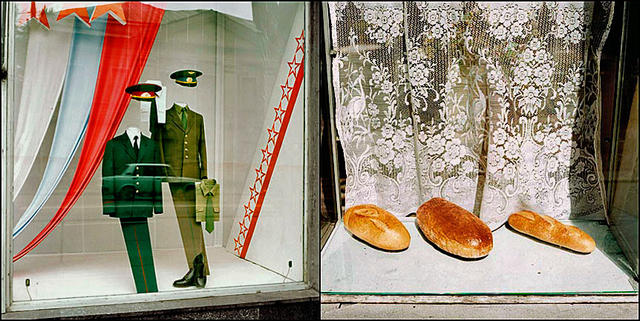 David Hlynsky's striking collection of store windows from Communist Europe is a peek into a weird, bleak, and sometimes comical view of consumer culture in a non-consumer society: Between 1986 and 1990, I made approximately 8,000 color, Hasselblad images on the streets of Communist Europe. I purposely avoided dramatic moments and newsworthy events. In a cityscape without commercial seduction, banality seemed to signify everything. At first I was interested in simple pedestrian traffic. Later I doggedly documented store windows. These seemed to signify the real difference between East and West. Without the garish ad campaigns of the West, these streets felt more neutral... devoid of trumped up and pumped up urgency.David Hlynsky Communist store windows (Thanks, Zoran!) |
| Shel Silverstein's UNDERWATER LAND, CD/book of hilarious kids' nautical music Posted: 22 Oct 2009 12:51 PM PDT  The Underwater Land project recently supplied me with an MP3 download of their CD, "Underwater Land," created by the late, great and sorely missed Shel Silverstein. This was the pitch: I'm writing you on behalf of the Shel Silverstein estate's Underwater Land project. Underwater Land is a kid's music project created by Shel Silverstein. This project was Shel's final major music project and also his final children's recording. Shel wrote Underwater Land, produced it, travelled to Nashville in 1997 to handpick the best musicians and studios there, and sings on several tracks with the primary singer and old friend Pat Dailey. Kim Llewellyn, Shel's longtime graphic designer, designed the lovely 32-page liner notes which features many previously unpublished Silverstein illustrations and all the song lyrics and verse.And here's my take: this is some seriously awesome kids' music, full of Silverstein's flawless, legendary rhyme, his wicked humor, and some damned fine music and playing beneath it. It's fast, witty, and full of jokes that work on levels that can be appreciated by pre-verbal toddlers -- the broad, comic recitations of songs like "Fish Guts," a kind of "I Am the Very Model of a Modern Major General" for the fish-kingdom -- by kids, and by adults, who will appreciate the snatches of extremely grown-up jokes woven into the whimsy. Some of my favorites: "Dale and Shale," a rapped advertisement for a notional store selling naught but tales (think of Tom Waits's "Pasties and a G-String" except about fish, not strippers); "Captain Octopus" (a rollicking sea chanty recounting the eight things a sailing octopus can do at once); and "Poor Anna," the sob-story of Anna, a flounder from Havana whose love affair is pull of superb and terrible fish puns (every now and again Silverstein and Dailey break each other up on this track, and I defy you not to do the same). If you're a Silverstein fan, a fish fan, a kid, a grownup with a kid, or have an intact sense of humor, you will enjoy the heck out of "Underwater Land." Underwater Land (Thanks, Kenyon!) |
| A drink that sounds even more unappetizing than "Dairy Drink" Posted: 22 Oct 2009 11:02 AM PDT  A couple of days ago I posted a photo of a container of "Dairy Drink," which turns out to be sugared and watered down skim milk. The above drink is just plain old milk, but did the person who came up with "Dairylea" really think it would make people want to drink it? |
| Building a brain inside a supercomputer Posted: 22 Oct 2009 09:12 PM PDT  Blue Brain is an IBM computer built to simulate a human brain. It's powered by 2,000 microchips, each acting as a single neuron, that enable it to execute 22.8 trillion operations per second. Based at the Ecole Polytechnique Fédérale de Lausanne, the project launched in 2005 to much controversy and skepticism. Modeling the complexity of the brain in a computer is considered a holy grail to some, and hubris to others. The Blue Brain Project isn't an attempt to build an artificial intelligence, although it could someday inform such an effort. That's because the scientists are hoping to use the machine to understand physiology, brain chemistry, and even intelligence and consciousness. The project's stated goal? "To reverse engineer the brain." Here's Markam talking at TEDGlobal this year: Already though, Blue Brain has simualated the brain's neocortical column, containing 10,000 neurons and 30 million synaptic connection. "The column has been built and it runs," project director Henry Markram told Seed Magazine. "Now we just have to scale it up." In two years, Markram hopes to have modeled a complete rat brain that he will then load into a mobile robot. From SEED: When listening to Markram speculate, it's easy to forget that the Blue Brain simulation is still just a single circuit, confined within a silent supercomputer. The machine is not yet alive. And yet Markram can be persuasive when he talks about his future plans. His ambitions are grounded in concrete steps. Once the team is able to model a complete rat brain--that should happen in the next two years--Markram will download the simulation into a robotic rat, so that the brain has a body. He's already talking to a Japanese company about constructing the mechanical animal. "The only way to really know what the model is capable of is to give it legs," he says. "If the robotic rat just bumps into walls, then we've got a problem."Blue Brain Project (EPFL) "Out of the Blue" (Seed) |
| LEGO recreation of Buddhist temple in Kyoto Posted: 22 Oct 2009 09:15 AM PDT What the internet is for: this video of a beautiful LEGO recreation of Kinkaku-ji, a Zen Buddhist temple in Kyoto, Japan constructed in the 14th century. The guy who built this LEGO replica says the project required 4,500 pieces. Don't miss the splendid golden pavillion reveal - watch the whole thing. (via brothers-brick, thanks Sebastian!) |
| US military data-mines America's kids for war recruiting Posted: 22 Oct 2009 08:57 AM PDT An amazing piece in Mother Jones on how the No Child Left Behind Act made it possible for military recruiters to gather personal data on millions of unsuspecting American teens. A Few Good Kids? (Mother Jones, via @dangerroom; image: Nina Berman/Redux, via Mother Jones) |
| You are subscribed to email updates from Boing Boing To stop receiving these emails, you may unsubscribe now. | Email delivery powered by Google |
| Google Inc., 20 West Kinzie, Chicago IL USA 60610 | |




 When I asked him whether he'd ever talked to a military recruiter, Travers, a 19-year-old African American with a buzz cut, a crisp white T-shirt, and a diamond stud in his left ear, smiled wryly. "To get to lunch in my high school, you had to pass recruiters," he said. "It was overwhelming." Then he added, "I thought the recruiters had too much information about me. They called me, but I never gave them my phone number."
When I asked him whether he'd ever talked to a military recruiter, Travers, a 19-year-old African American with a buzz cut, a crisp white T-shirt, and a diamond stud in his left ear, smiled wryly. "To get to lunch in my high school, you had to pass recruiters," he said. "It was overwhelming." Then he added, "I thought the recruiters had too much information about me. They called me, but I never gave them my phone number."
No comments:
Post a Comment